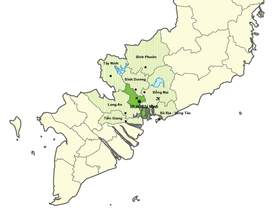
Back Aire urbaine d'Hô Chi Minh-Ville French Área Metropolitana da Cidade Ho Chi Minh Galician Região metropolitana da Cidade de Ho Chi Minh Portuguese ہو چی من شہر میٹروپولیٹن علاقہ Urdu Vùng đô thị Thành phố Hồ Chí Minh Vietnamese
Ho Chi Minh City Metropolitan Area
Vùng đô thị Thành phố Hồ Chí Minh | |
|---|---|
 Ho Chi Minh City, the largest city in the metropolitan area | |
 Map of Ho Chi Minh City metropolitan area consists of 7 provinces and Ho Chi Minh City | |
| Country | |
| Subdivisions | |
| Major cities | - Thủ Dầu Một (Bình Dương province) - Dĩ An (Bình Dương province) - Thuận An (Bình Dương province) - Đồng Xoài (Bình Phước province) - Biên Hòa (Đồng Nai province) - Long Khánh (Đồng Nai province) - Bà Rịa (Bà Rịa–Vũng Tàu province) - Vũng Tàu (Bà Rịa–Vũng Tàu province) - Mỹ Tho (Tiền Giang province) - Tân An (Long An province) - Tây Ninh (Tây Ninh province) - Thủ Đức (Ho Chi Minh City) |
| Area | |
| • Metro | 30,595 km2 (11,813 sq mi) |
| Population | |
| • Metro | 21,281,639 |
| • Metro density | 700/km2 (1,800/sq mi) |
| GDP | |
| • Metro | VND 3,172 trillion US$ 133.076 billion (2023) |
| Time zone | UTC+7 (UTC +7) |
Ho Chi Minh City metropolitan area (Vietnamese: Vùng đô thị Thành phố Hồ Chí Minh) is a metropolitan area that was in June 2008 proposed by the Ministry of Construction of Vietnam to the Government of Vietnam for approval. According to this master plan, this metropolitan area will include provinces around Ho Chi Minh City in the Southeast region and 2 provinces in the Mekong Delta region.
This metropolitan area currently has an area of 30,404 square kilometres with radius of 150–200 km, a population of 20–22 million inhabitants, of which urban residents account for 16–17 million indicating an urbanisation rate of 77–80%. By 2050, the population will have increased to 25-27 million people, and the urbanized rate is estimated to rise to 90%. Constructed land will be 1800–2100 square kilometres by 2020.[1] Ho Chi Minh City will be the core urban center of the area while other surrounding cities and towns will play their role as satellite municipalities. Baria-Vungtau will serve as the main deepwater seaport of the region, especially Sao Mai-Ben Dinh seaport, Thi Vai Port. Long Thanh International Airport and Tan Son Nhat International Airport will serve as the air traffic hub of the region. Hi-tech park will be located in Ho Chi Minh City while other heavy industry will concentrate in Đồng Nai, Bình Dương and Bà Rịa–Vũng Tàu. Vũng Tàu is planned to serve as a tourism hub, with coastal beaches and several entertainment resort projects. [1][2][3]
- ^ a b "Quy hoạch xây dựng vùng thành phố Hồ Chí Minh (Master Plan for Ho Chi Minh City Metropolitan Area)". 2008-05-01.
- ^ "Vung Tau Offers Beach and Sun". baobariavungtau.com.vn/english. 2008-05-23.
- ^ "Ho Tram Strip - A $4.2 billion Resort in Vietnam". luxuo.com. 2008-06-06.